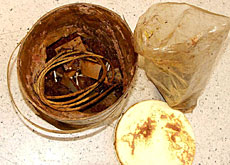Swiss explosives tracing attracts EU interest

The Swiss system of monitoring the movement of explosives with micro-tags may be adopted across Europe following an apparent terrorist plot to blow up aircraft.
European Commissioner for Justice, Freedom and Security Franco Frattini wants “taggant” technology to top the bill at a conference in November looking at ways to combat the growing threat.
British airports were put on high alert last week as police said they had thwarted a plan to detonate bombs on board planes flying to the United States. The plotters were reportedly planning to use liquid explosives disguised as drinks, a discovery that prompted hand luggage restrictions on many flights.
Since 1980, Swiss law has obliged explosives producers to mix in microscopic marker tags that label each batch with a unique identity. This makes it easier for police to trace the origins of explosives and to check whose hands they have passed through.
Switzerland is the only country in the world to have this safeguard enshrined in law.
“They have a pretty solid system that obliges producers to inform police of explosive materials which they produce, transport and store,” Frattini’s spokesman, Friso Roscam Abbing said.
“This could tremendously assist us in the detection and identification of potentially dangerous material.” However, the system does not offer a foolproof means of stopping terrorists using bombs.
“It is easy to track explosives in normal daily life because you can see where they are bought from and who they are going to,” Swiss explosives expert Gunter Schwarz cautioned.
“But this system is only part of the solution because terrorists operate outside this circle and will look to find explosives from other places,” he told swissinfo.
Not sole answer
The Swiss Federal Police Office (Fedpol) also counsel that taggants are not the sole answer to foiling bomb plots, but say the system does have practical uses.
“You cannot determine the identity of perpetrators with this marking system alone, but it is an important part of the mosaic of police work,” Fedpol spokesman Claude Müller told swissinfo.
“If the explosives are marked then you stand more of a chance, but without it then the odds of success are significantly reduced.”
The European Commission’s conference on terrorism will invite experts to give their views on the production, sale, distribution and detection of explosives.
An earlier meeting of EC ministers in October will discuss measures to control the misuse of explosive material. A proposed law to ban books outlining how to make bombs will be discussed at this meeting.
swissinfo, Matthew Allen with agencies
Identification taggants are microscopic particles usually made of multiple layers of different coloured plastic strips bonded to a magnetic material. The coloured strips make up a unique bar code that can be used to identify the explosive material.
Other taggants employ a chemical “fingerprint” that can be identified by sniffer dogs or specialist machines. They are designed to survive the impact of an explosion.
The technology was first developed by US technology group 3M in the 1970s.

In compliance with the JTI standards
More: SWI swissinfo.ch certified by the Journalism Trust Initiative












You can find an overview of ongoing debates with our journalists here . Please join us!
If you want to start a conversation about a topic raised in this article or want to report factual errors, email us at english@swissinfo.ch.